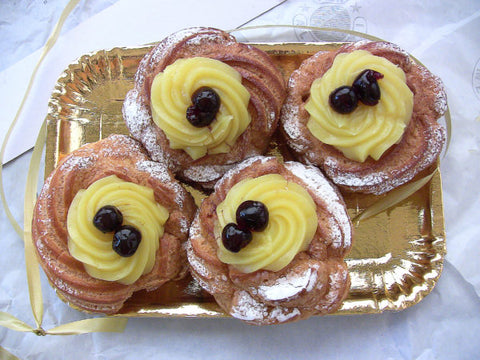Every March 19th, Sicilian families gather to share amazing food, good times, and laughter in honor of St. Joseph (San Giuseppe in Italian), the Patron Saint of Sicily.
The legend follows that during a particularly bad drought, many farmers prayed to San Giuseppe for rain, promising to honor him with a feast if their prayers were answered. With luck, the rain came down and the feast began! Today, the tradition has spread across Italy and into the US as well. The celebration is accompanied by song, dance, and of course, amazing traditional dishes such as Maccu di San Giuseppe, Zeppole, and Pasta Milanese. Take part in the festivities this year by preparing some of these dishes with your family!
Pasta Milanese

There is none more famous a dish than Pasta Milanese on San Giuseppe Day! A traditional Sicilian dish with a rich backstory, it’s made up of Ortiz sardines (a family recipe 100 years strong), passata(a classic strained tomato puree), Cuoco “condimento” (a special seasoning made just for this dish) and fresh toasted breadcrumbs. Pasta Milanese is always accompanied by family, laughter, and lots of St. Joseph sawdust. San Giuseppe was a carpenter, so a big part of this dish is the toasted breadcrumb finish on this dish, signifying wood shavings, or “sawdust.” This is an old family recipe, but feel free to add a twist to make it a tradition of your own!
Sfinci di San Giuseppe

St. Joseph was not just any Patron Saint - he was the Patron Saint of pastry cooks. Sfinci, closely related to the Neapolitan Zeppole, are fried pastry puff sometimes filled with cannoli cream, or simple dredged in sweet powdered sugar. The word Sfinci is believed to be derived from the Arabic word sfang, meaning "light and airy." If you were to find yourself in Sicily during the festivities, it'd be hard to find someone who isn't enjoying one of these delightfully airy treats.
Maccu di San Giuseppe
Maccu is a traditional fava bean soup often served on San Giuseppe day. It was thought that the fava bean was the crop that saved Sicily from starvation after St. Joseph ended the notorious drought. Today, fava beans are an important ingredient in many St. Joseph’s Day dishes and traditions. Maccu was originally made with the dried beans of the last harvest, following in step with the spring mantra “out with the old and in with the new.” Whether you’re looking to celebrate San Giuseppe Day, or just looking to clear out some greens in your fridge, this maccu is an excellent choice.
How does your family celebrate La Festa di San Giuseppe? Let us know in the comments below.
2 comments
Love St. Joseph
My noona’s came from Scilly and I have many St Joseph altars and try to keep up the tradition that and taught me, Carmel